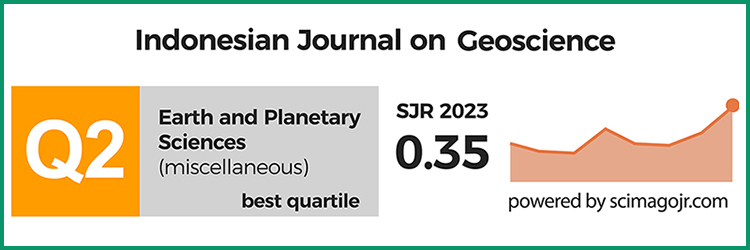Melanic and Fulvic Andisols in Volcanic Soils derived from some Volcanoes in West Java
DOI:
https://doi.org/10.17014/ijog.7.4.227-240Keywords:
andesitic, basaltic, Holocene, Pleistocene, Pinus merkusiiAbstract
Melanic and fulvic Andisols are the great groups in the classification of volcanic soils Andisols, which describe the soils with high organic carbon content in the epipedon. The organic C must be more than 6% in the upper 30 cm with the value and chroma are 2 or less for melanic and more than 2 for fulvic. Melanic epipedon also has to have the melanic index that is 1.70 or less. The objective of this study is to investigate the melanic and fulvic Andisols in volcanic soils that developed under pine forest vegetation (Pinus merkusii) from different parent materials and ages of Mount Tangkuban Parahu (andesitic, Holocene) and Mount Tilu (basaltic, Pleistocene). The method used was a descriptive comparative survey of three profiles in Mount Tangkuban Parahu and three profiles in Mount Tilu. Analyses were done for each horizon in the profiles comprising the investigation of andic soil properties through the analyses of organic C, bulk density, Al + ½ Fe (ammonium oxalate), and P-retention. The investigations were continued by further calculation of organic C content and by investigation of soil colour with Munsell Soil Colour Chart. The results showed that the two profiles in Mount Tangkuban Parahu and two profiles in Mount Tilu are fulvic Andisol. No melanic Andisols were found in both locations. Pine forest vegetation encourages the formation of fulvic Andisols were derived from andesitic-Holocene parent materials or basaltic-Pleistocene parent materials.
References
Alzwar, M., Akbar, N., and Bachri, S. , 1976. Geology of Garut Quadrangle. Geological Research and Development Centre, Bandung.
Blake, G.R. and Hartge, K.H.,1986. Bulk Density. In: Klute, A. (ed), Methods of Soil Analysis, Part I Physical and Mineralogical Methods, p.363-375. doi:10.2136/sssabookser5.1.2ed.c13
Blakemore, L. C., Searle, P. L., and Daly, B. K., 1987. Methods for Chemical Analysis of Soils. Lower Hutt, New Zealand. Soil Bureau Science Report,80pp.
Devnita, R., Arifin, M., Salim, E. H., Sudrajat, H., Hudaya, R., and Van Ranst, E., 2010. Soil developed on volcanic materials in West Java, Indonesia. International Journal of Arts and Sciences, 9, p.180-192.
Honna, T., Yamamoto, S., and Matsui, K., 1988. A simple procedure to determine the melanic index that is useful for differentiating melanic from fulvic Andisols. Pedologist, 32, p.69-75.
Imaya, A., Morisada, K., and Ohta, S., 2002. Chemical Properties and Classificaion of Japanese Brown Forest Soils Derived from Various Parent Materials. Proceedingson J'J'hWCSS, 14-21 August 2002, Thailand.
Ito, T., Shoji, S., and Saigusa, M., 1991. Classification of volcanic ash soils from Konsen district Hokkaido according to the last Keys to Soil Taxonomy. Journal of Soil Science Plant Nutrition, 62, p.237-247.
Leamy, M.L., 1988. International Comrnitee on Andisol (ICOMAND). Circular Letter no 10. New Zealand Bereau. DSIR. Lower Hutt.
Leamy. M.L., Kinloch, D. 1., and Parfitt, R. L., 199 0. International Commitee on Andisol. Soil Management Support Services, Washington DC.Technical Monograph, 20. 78pp.
National Soil Survey Center (NSSC), 2002. Field Book for Describing and Sampling Soils Version 2. 0. Natural Resources Conservation Service. United State Departement ofAgriculture, 219pp.
Ottawa, M., 1985. Criteria of great group of Andisols. In: Beinroth, F. E., Maldonado, P., and Eswaran, H., (Eds.). Proceedings of 6'h International Soil Classification Workshop, Chile and Equador, p.191-208.
Schmidt,T. and Fergusson, B., 1951. Climatology. Blacksburg, Virginia. 263pp.
Shoji, S., 1988. Separation of melanic and fulvic Andisols. Soil Science and Plant Nutrition, 34, p.303-306. doi:10.1080/00380768.1988.10415686
Shoji, S., Fujiwara, Y., Yamada, I., and Saigusa, M., 1982. Chemistry and clay mineralogy of Ando soils, Brown forest soils and Podzolic soils formed from recent Towada ashes, northeastern Japan. Soils Science, 33, p.69-86. doi:10.1097/00010694-198202000-00001
Shoji,S.,Takahashi,T.,Saigusa,M.,Yamada,1.,and Ugolini, F.C., 1 988. Properti es of Spodosols and Andisols showing climosequential and biosequential relations in southern Hokkoda, North-eastern, Japan. Soil Science, 145,p.l35-150. doi:10.1097/00010694-198802000-00007
Shoji, S., Nanzyo, M., and Dahlgren, R., 1993. Genesis of volcanic ash soils. In: Shoji, S., Nanzyo, M. and Dahlgren, R., (Eds.). Volcanic Ash Soil - Genesis, Properties and Utilization. Elsevier, Amsterdam, p.37-71. doi:10.1016/s0166-2481(08)70264-2
Shoji, S., Ito, T., Saigusa, M., and Yamada, I., 1985. Properties of nonallophanic Andosols from Japan. Soil Science, 140, p.264-277. doi:10.1097/00010694-198510000-00005
Shoji, S., Takahashi, T., Saigusa, M., Yamada, I., and Ugolini, F.C., 1988. Properties of Spodosols and Andisols showing climosequential and biosequential relation in southern Hakkoda, northeastern Japan. Soil Science, 145, p.135-150. doi:10.1097/00010694-198802000-00007
Silitonga, P. H., 2003. Geology of Bandung Quadrangle. Geological Research and Development Centre, Bandung.
Smith, G. D., 1978. A Preliminary Proposal for the Reclassification of Andept and Some Andie Subgrops. New Zealand Soil Bureau, New Zealand. 48pp.
Soil Survey Staff, 1990. Keys to Soil Taxonomy. 4'h ed. AID. USDA. SMSS. Technical Monograph No. 19. Blacksburg, Virginia, 280pp.
Soil Survey Staff, 2010. Keys to Soil Taxonomy. ll'h ed. Natural Resources Conservation Service, 332pp.
The Third Divison of Soils, 1973. Criteria for making soil series and a list of soil series. The first approximation. National Institute of Agricultural Research.
Van Reeuwijk, L. P., 1992. Procedure for Soil Analysis. Fourth Edition, ISRlC. Wageningen, The Netherland, 56pp.
World Reference Base, 2006. World Reference Based for World Soil Resources. A Framework for International Classification, Correlation and Communication. fUSS Working Group, FAO, Rome Report No. 103. 130pp.



















